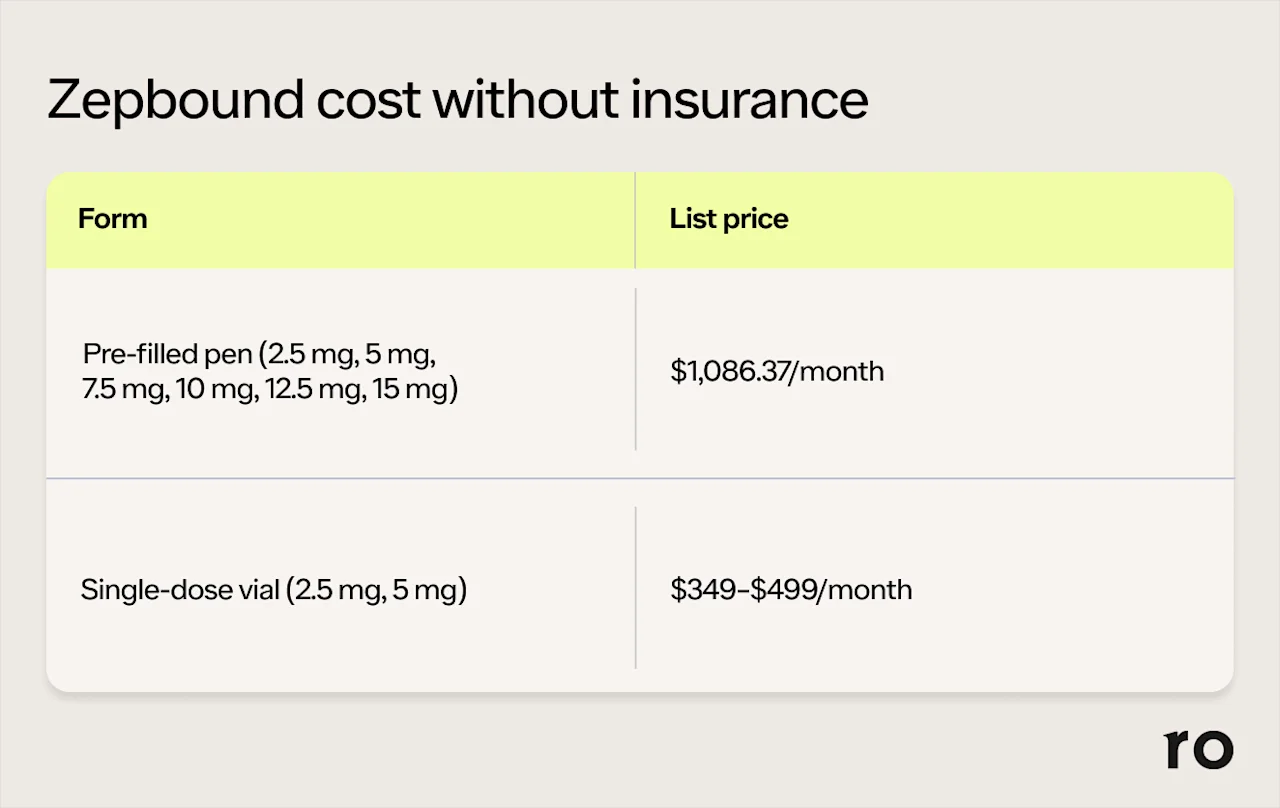Key takeaways
Without insurance, Zepbound costs $1,086.37 for a one-month supply, but insurance and discount cards can help bring the price down.
Whether your insurance covers Zepbound will depend on your plan’s prescription drug coverage.
The Zepbound Savings Card can bring the cost of Zepbound with insurance down to as low as $25 for a one- or three-month prescription.
Here's what we'll cover
Key takeaways
Without insurance, Zepbound costs $1,086.37 for a one-month supply, but insurance and discount cards can help bring the price down.
Whether your insurance covers Zepbound will depend on your plan’s prescription drug coverage.
The Zepbound Savings Card can bring the cost of Zepbound with insurance down to as low as $25 for a one- or three-month prescription.
Zepbound (tirzepatide) is a once-weekly injectable medication for weight loss, prescribed in combination with diet and exercise. While the drug can produce impressive slim-down results, achieving such effects might come with a considerable price tag. Without insurance, Zepbound costs more than $1,000 per month. And with insurance? It can still stretch beyond pocket change. The good news, however, is that there are plenty of ways to save on the medication, regardless of your insurance coverage or lack thereof.
Below, we break down the cost of Zepbound with and without insurance, compare these prices to those of other drugs like Wegovy (semaglutide), and share savings tips for your monthly refill.
How much does Zepbound cost without insurance?
The list price for Zepbound is $1,086.37 for one package of the medication, which comes out to $271.59 per week or $14,122.68 per year. Each package of Zepbound contains four prescription pens, each pre-filled with a single dose of the medication.
The list price describes the cost at which Eli Lilly, Zepbound’s manufacturer, sells the drug to wholesalers. The actual retail price tends to be higher and can vary by pharmacy. Ultimately, however, the amount you’ll pay for Zepbound will depend on various factors, such as your insurance coverage (if any), preferred pharmacy, and location.
Here’s the price of four 2.5 mg/0.5 mL pens (i.e. a month’s supply) of Zepbound different pharmacies, according to GoodRx:
Walgreens | $1,284 |
CVS | $1,250 |
Rite Aid | $1,280 |
Duane Reed | $1,272 |
*While prices were valid at the time of publication, they may vary based on date and location. For the most accurate estimates, refresh the GoodRx searches and enter your zip code.
You can price-shop different pharmacies in your area using sites like GoodRx and SingleCare, which can help you save up to 20% off the medication.
What you pay for Zepbound without insurance can also vary depending on the prescribed form of the drug. In addition to pre-filled pens, certain doses of Zepbound are available in single-dose vials, which can be purchased with cash (keywords!) through LillyDirect, the manufacturer’s self-pay pharmacy, or Ro. Here are the cash prices of a four-week supply of Zepbound single-dose vials:
2.5 mg dose: $349/month
5 mg dose: $499/month

Does insurance cover Zepbound?
Whether your insurance plan covers Zepbound will depend on your plan’s prescription drug coverage and the pharmacy you use to fill your prescription. To find out if Zepbound is covered by your insurance plan, review your plan’s drug formulary, which lists all the drugs eligible for coverage under your plan. You can also contact your insurance provider directly by calling the phone number on the back of your insurance card. When insurance does cover Zepbound, prior authorization is typically required.
If your plan does not include coverage for Zepbound, your healthcare provider can submit an appeal letter on your behalf to your insurance company requesting an exception and coverage. Be aware, however, that these appeals are not always successful.
Is Zepbound covered by Medicare?
In general, Medicare does not cover weight loss drugs or medications prescribed to treat obesity and overweight. In some cases, certain Medigap and Medicare Advantage plans may provide coverage. Contact Medicare to see if Zepbound is covered by your specific plan.
However, this may change in the near future. As of December 2024, Zepbound is now approved as the first medication for the treatment of obstructive sleep apnea. It’s possible that Medicare will cover Zepbound for sleep apnea, but as of publication, it’s too early to know.
Is Zepbound covered by Medicaid?
Medicaid coverage for Zepbound, as well as other drugs, can vary by state. Visit the Medicaid site for your state and review the Medicaid Preferred Drug List (PDL) to check if your Medicaid plan offers coverage for Zepbound. If it doesn’t, your healthcare provider can submit an appeal on your behalf.
Is Zepbound covered by VA Benefits or TRICARE?
It is possible that Veterans Affairs may provide coverage for Zepbound through its MOVE! Program. Contact your VA provider or local MOVE! Coordinator to learn more.
TRICARE may also provide coverage for Zepbound. Your healthcare provider will need to request a coverage review on your behalf.
Zepbound vs. Mounjaro cost
Zepbound isn’t the only medication that contains tirzepatide as its active ingredient. There’s also Mounjaro. Mounjaro has a slightly higher list price than Zepbound, at $1,079.77 per fill, but it comes in the same dosage strengths and is also a weekly injection made by Eli Lilly. The main difference between Zepbound and Mounjaro, however, is their specific uses, as approved by the US Food and Drug Administration (FDA), along with lifestyle changes:
Zepbound is approved for weight loss and weight maintenance in adults with obesity or overweight with a weight-related medical condition; Zepbound is also approved for sleep apnea in adults with obesity.
Mounjaro is approved to manage blood sugar levels) in adults with type 2 diabetes.
Even though the medications have different indications, your healthcare provider may choose to prescribe Mounjaro off-label for weight loss if they think it’s the right choice for you. And if you have type 2 diabetes, you may be able to get Mounjaro covered by your insurance, which can make it more affordable than Zepbound. Medicare, for instance, can cover type 2 diabetes medications like Mounjaro. If you have prescription drug coverage through Medicare Part D, you’ll need to check your plan’s formulary to see if Mounjaro is covered.
Eli Lilly also offers a savings program for Mounjaro, which can further reduce the cost of Mounjaro if you have commercial insurance. For those with a plan that includes coverage for Mounjaro, the Mounjaro Savings Card lowers the price of a one- or three-month fill of Mounjaro to $25. For those with a plan that doesn’t include coverage for Mounjaro, the card offers a savings of up to $463 for a one-month fill. People with government-funded insurance, such as Medicaid, Medicare, TRICARE, or VA, are not eligible for this Mounjaro coupon.
Bottom line: While Zepbound and Mounjaro contain the same active ingredient and can promote ample weight loss, only Zepbound is FDA-approved for such use. That said, if your healthcare provider determines prescribing Mounjaro off-label for weight loss is a fit for you, then it might be worth comparing the drugs’ prices. Here are their list prices:
Zepbound: $1,086.37/month
Mounjaro: $1,079.77/month
Zepbound vs. Wegovy cost
Wegovy (semaglutide) can be another affordable alternative to Zepbound. Like Zepbound, Wegovy a weekly injection that’s FDA-approved for weight loss and weight management. Unlike Zepbound, Wegovy is also approved to reduce the risk of serious cardiovascular problems in certain adults with heart disease. Insurance plans can choose which drugs to cover, and some may opt to cover Wegovy over Zepbound (or vice versa), which may make it more affordable depending on the details of your plan. If you’re paying cash, however, Wegovy is typically more expensive than Zepbound, with a list price of $1,349.02 for a one-month supply.
Even with its higher list price, some people may opt for Wegovy over Zepbound. If your insurance covers it, Wegovy can be more affordable than Zepbound, especially if you’re eligible for the Wegovy Savings Offer, which brings the cost of Wegovy down to $0—which is lower than the $25 price offered by the Zepbound Savings Card. For those with commercial drug insurance, but with a plan that does not cover Wegovy, the Wegovy Savings Offer caps the price at $650 per month, similar to the Zepbound Savings Card.
Pricing and savings aside, the question of Zepbound vs. Wegovy is one that has to be answered by you and your healthcare provider. In terms of effectiveness, separate studies suggest that Zepbound may lead to more weight loss than Wegovy, as follows:
In clinical trials, people taking the highest dose of Wegovy (2.4 mg) lost 14.9% of their body weight in 68 weeks, while those taking a placebo (fake) injection lost 2.4%.
In a separate trial with a time frame of 72 weeks, people taking the maximum dose of Zepbound (15 mg) lost 20.9% of their body weight. Even those taking the lowest maintenance dose of Zepbound (5 mg) experienced an average weight loss of 15%. In contrast, those taking a placebo lost 3.1% of their body weight.
Side effects are another consideration. While both drugs share many of the same gastrointestinal side effects, there are some areas where they don’t overlap. Wegovy includes cold-like symptoms in its list of common side effects, while Zepbound’s list of common side effects includes hair loss. Serious side effects are also similar between the two medications, including kidney or gallbladder problems. However, increased heart rate is only listed in the warnings for Wegovy, not Zepbound.
Bottom line: Both Zepbound and Wegovy cause significant weight loss, but there are some nuances between the drugs for you and your healthcare provider to consider. If your only concern is cost, Wegovy is more expensive than Zepbound out-of-pocket, but one or the other may be cheaper depending on your insurance plan and eligibility for any savings programs.
Here are their list prices:
Zepbound: $1,086.37/month
Wegovy: $1,349.02/month
How to get Zepbound
You need a prescription from a licensed healthcare provider to get Zepbound. Zepbound is typically prescribed in combination with diet and exercise for the following uses:
To help with weight loss and weight management in adults who have obesity or overweight and at least one weight-related health condition, such as high blood pressure, high cholesterol, type 2 diabetes, or heart disease
To treat moderate-to-severe obstructive sleep apnea in adults with obesity
You can get a prescription for Zepbound from your primary care provider, a specialist in obesity medicine, or through the Ro Body membership, a comprehensive program that includes:
Your weight loss medication (including Zepbound, if that’s the most appropriate medication for you)
Metabolic testing included
A personalized treatment plan
1:1 health coaching
A step-by-step curriculum
Ongoing support from your provider
Insurance concierge services to help you get coverage for Zepbound
How to save on Zepbound
However you pay for Zepbound, with or without insurance, you may be eligible for additional savings. Currently, there are three main ways people lower the cost of Zepbound: applying for the Zepbound Savings Card, paying with a pharmacy discount, or using self-pay programs for single-dose vials instead of autoinjector pens.
Zepbound Savings Card
If you have commercial drug insurance, whether through your employer or purchased independently, you may be eligible for the Zepbound Savings Card. For people whose plan includes coverage for Zepbound, this Zepbound coupon can bring the price of the medication down to as low as $25 for a one- or three-month prescription. For those whose plan does not include coverage, the coupon can bring the cost down to as low as $650 for a one-month supply of Zepbound.
To be eligible for the Zepbound coupon offered by Eli Lilly, you must:
Have a prescription for Zepbound
Be enrolled in a commercial drug insurance plan
Not have insurance coverage through any state, federal, or government-funded program, such as Medicare, Medicaid, VA, or TRICARE
Be a resident of the US or Puerto Rico
Be at least 18 years old
Zepbound coupons and prescription cards
If you don’t qualify for the official Zepbound Savings Card offered by Eli Lilly, you still have options for reducing the cost of Zepbound without insurance. Several websites offer pharmacy discount cards that can help you save significantly on Zepbound and other prescription drugs.
Once you’ve signed up (which is free, by the way), you simply search for your dosage of Zepbound, download the coupon for your preferred pharmacy, and show it to your pharmacist when you pick up your prescription. There is one caveat, however: These Zepbound coupons cannot be combined with insurance discounts.
SingleCare: This website partners over 35,000 pharmacies to offer savings on over 10,000 prescription drugs. With their coupon, you can pay between $906–$1,020 for Zepbound, which is hundreds off the retail price.
GoodRx: This website partners with over 70,000 pharmacies to offer savings on various prescription drugs. Their coupon brings the price of Zepbound to as low as $995, which is 20% off the average retail price.
Optum Perks: This website partners with over 64,000 pharmacies. At the time of writing, their CVS coupon for Zepbound brings the cost down to $1,025.
WellRx: This website partners with over 65,000 pharmacies. Their coupon brings Zepbound’s cost down to $1,039–$1,160.
If you’re a Costco member, you can fill your prescription there or at one of their participating pharmacies for a lower cost. At the time of writing, Zepbound is $1,078.99 at Costco or $1,080.79 for home delivery.
Zepbound single-dose vials
Depending on your prescription, you may be able to purchase Zepbound single-dose vials for a lower price. Similar to the autoinjector pens, each vial contains a single dose of the medication. However, you’ll need to use a separate syringe and needle to extract the medication from the vial and give yourself a shot (this process differs from the pens, which each come with a needle attached).
The single-dose vials cost half the list price of Zepbound or less when you get them from a self-pay program, including Lilly Direct or Ro. As mentioned above, here are the monthly costs for the two dosage strengths:
2.5 mg dose: $349/month
5 mg dose: $499/month
These prices cannot be discounted further and cannot be combined with any insurance or savings cards. With a prescription, you can purchase Zepbound single-dose vials online directly through Eli Lilly or through Ro.
Zepbound single-dose vials can be a potentially more affordable option for people who are starting the drug (2.5 mg dose) or only need the lowest maintenance dosage (5 mg). (Zepbound follows a titrated dosing schedule, in which your provider prescribes a starting dose of 2.5 mg and gradually increases it over a period of months until you reach a maintenance dosage that is effective for you, usually 10 mg or 15 mg.)
How does Zepbound work?
In clinical trials, people taking Zepbound (in addition to diet and exercise) lost an average of 15–21% of their body weight within a year and a half, depending on their dosage. In more concrete terms, this amounted to an average of 35–52 pounds lost compared with their weight before they started the study. The participants taking a placebo, on the other hand, lost just around 5 pounds with diet and exercise alone.
Zepbound is what’s known as a GLP-1/GIP receptor agonist, a designation it shares with Mounjaro. Unlike similar medications like Ozempic, Wegovy, and Saxenda, Zepbound and Mounjaro are unique in that their active ingredient—tirzepatide—targets two receptors involved in appetite regulation and metabolism. These are the receptors for glucagon-like peptide 1 and glucose-dependent insulinotropic polypeptide, hence the GLP-1 and GIP. Drugs like Ozempic and Wegovy, on the other hand, solely target the GLP-1 receptor. This dual-receptor ability may be what makes tirzepatide, marketed under Zepbound and Mounjaro, so effective for weight loss.
So, how does Zepbound help you lose weight, exactly? Tirzepatide acts upon the GLP-1 and GIP receptors to accomplish a few different things, including:
Slowing down digestion so food stays in your stomach longer, and you feel full sooner
Sending satiety (fullness) signals to tell your brain that you are full
Influencing your brain’s reward center around food, reducing your cravings for certain foods
Zepbound is injected on a weekly basis, subcutaneously (under the skin) of your belly, thigh, or upper arm. It is available in six dosage strengths, ranging from 2.5 mg to 15 mg. Typically, your healthcare provider will prescribe a lower starting dose before slowly ramping up the dosage every four weeks or so in order to reduce side effects, which may include:
Nausea
Diarrhea
Vomiting
Constipation
Abdominal pain
Upset stomach or indigestion
Injection site reactions (e.g. rash)
Fatigue
Belching
Acid reflux
Zepbound is safe and effective for many people, but it is not right for everybody, including people who are pregnant or breastfeeding and those with a personal or family history of certain thyroid cancers. Talk to your healthcare provider about whether Zepbound is a good fit for you.
Are there cheaper alternatives to Zepbound?
Yes, there are some cheaper alternatives to Zepbound. These include compounded semaglutide as well as oral weight loss pills like Qsymia (phentermine/topiramate) and Contrave (naltrexone/bupropion).
Compounded semaglutide contains the same active ingredient as Wegovy. But it’s important to note that while legal, compounded medications do not undergo the same review process as their FDA-approved, brand-name counterparts. So, if your healthcare provider recommends compounded semaglutide, it’s important to ensure you purchase it from a licensed compounding pharmacy that complies with federal and state laws.
The table below lists the prices for cheaper Zepbound alternatives, along with the cost of Zepbound and the other GLP-1 injections approved for weight loss (i.e. Saxenda and Wegovy), even though they are more expensive.
Medication | List Price for Monthly Supply | FDA-Approved Indications |
|---|---|---|
Zepbound (tirzepatide) pens | Weight loss; sleep apnea | |
Zepbound (tirzepatide) single-dose vials | Weight loss; sleep apnea | |
Wegovy (semaglutide) | Weight loss; cardiovascular risk reduction in people with heart disease and obesity or overweight | |
Compounded semaglutide | Varies | N/A |
Saxenda (liraglutide) | Weight loss | |
Qsymia (phentermine/topiramate) | $98 (self-pay, cash price) | Weight loss |
Contrave (naltrexone/bupropion) | $99 or less (self-pay, cash price) | Weight loss |
Hear from Ro patients
Ro members taking branded GLP-1 medications were paid for their testimonials.
Bottom line
When it comes to weight loss medications, Zepbound stands out for its impressive results, but also its high cost. Understanding the factors that influence Zepbound’s price and taking advantage of ways to make it more affordable can make your next trip to the pharmacy feel less daunting.
The list price for Zepbound is $1,086.37 for a monthly supply, but retail prices are typically higher. For those paying out-of-pocket for Zepbound, the cost per year can exceed $14,000, making it one of the more expensive options for weight loss medications.
Insurance coverage and the Zepbound Savings Card can bring costs down significantly. Patients paying cash may consider Zepbound single-dose vials, which start at $349, or explore pharmacy discount cards like GoodRx and SingleCare to reduce costs further.
Insurance coverage for Zepbound depends on your specific plan. While many private insurers may cover it, prior authorization is often required. Medicare rarely covers weight loss drugs, and Medicaid’s coverage varies by state.
Zepbound can offer superior weight loss results compared to similar medications like Wegovy, but the costs of the drugs can be comparable depending on insurance and available savings programs. Exploring all options with your healthcare provider can help you identify the best fit for your weight loss goals and wallet.
Frequently asked questions (FAQs)
What is the cheapest way to get Zepbound?
The cheapest way to get Zepbound is to have an insurance plan that covers it and use the Zepbound Savings Card from Eli Lilly. That can lower the cost of your monthly refill to $25. The next cheapest way is to get the Zepbound single-dose vials through LillyDirect or Ro, which cost $349–$499 per month, depending on the dosage strength prescribed. If your healthcare provider recommends increasing your dosage to 7.5 mg or higher, you can still save on Zepbound by using the Zepbound Savings Card (if you’re eligible) or taking advantage of prescription discount cards on sites like GoodRx and SingleCare.
How much does Zepbound cost per month?
The monthly price of Zepbound depends on your insurance coverage and the pharmacy you use. The cost of Zepbound with insurance may be as low as $25 if you’re eligible for the Zepbound Savings Card. Without insurance, it can range from $1,250–$1,350, according to SingleCare, but you can lower the price by using pharmacy discount cards. Additionally, you can access Zepbound vials starting at just $349 per month.
What insurance covers Zepbound?
Insurance coverage for Zepbound depends on your provider and plan. Many private insurance plans cover Zepbound, especially if it’s deemed medically necessary, but you may need prior authorization. Medicare typically does not cover weight loss medications like Zepbound, and Medicaid coverage can vary by state. The best way to find out if your insurance covers Zepbound is to contact your insurance plan directly.
Why won’t insurance cover Zepbound?
High-cost drugs like Zepbound are often subject to stricter guidelines to help insurance companies control their expenses. Insurance may not cover Zepbound if it’s not included in your plan’s formulary (list of covered medications) or if there are less expensive alternative medications available. Additionally, some plans require proof of medical necessity or prior authorization, and failing to meet these requirements can lead to denial of coverage.
Why is Zepbound so expensive?
Zepbound is expensive largely due to patent protection. This patent grants Eli Lilly and Co the exclusive rights to manufacture and sell tirzepatide (the active ingredient in Zepbound), preventing other companies from producing a similar version until the patent expires. Eli Lilly’s exclusive patent on tirzepatide isn’t set to expire until 2036. Once it expires, other manufacturers will be able to create generic versions of Zepbound, and tirzepatide may have a lower cost. Generics are typically far more affordable than brand-name medications, but it’s unlikely that a generic version of Zepbound will be available for at least another decade.
DISCLAIMER
If you have any medical questions or concerns, please talk to your healthcare provider. The articles on Health Guide are underpinned by peer-reviewed research and information drawn from medical societies and governmental agencies. However, they are not a substitute for professional medical advice, diagnosis, or treatment.
Zepbound Important Safety Information: Read more about serious warnings and safety info.
Wegovy Important Safety Information: Read more about serious warnings and safety info.
Mounjaro Important Safety Information: Read more about serious warnings and safety info.
Ozempic Important Safety Information: Read more about serious warnings and safety info.
Saxenda Important Safety Information: Read more about serious warnings and safety info.
GLP-1 Important Safety Information: Read more about serious warnings and safety info.
Congressional Research Service. (2024). Medicare Coverage of GLP-1 Drugs. Retrieved from https://crsreports.congress.gov/product/pdf/IF/IF12758
Costco. (n.d.). Zepbound - Member Prescription Program Prices. Retrieved from https://www.costco.com/cmpps?drugIdentifierParam=55557705156&drugNameParam=Zepbound
Currax. (n.d.). Save on CONTRAVE. Retrieved from https://contrave.com/save/
Eli Lilly. (2023). FDA Approves Lilly's Zepbound™ (tirzepatide) for Chronic Weight Management, a Powerful New Option for the Treatment of Obesity or Overweight with Weight-Related Medical Problems. Lilly Investors. Retrieved from https://investor.lilly.com/news-releases/news-release-details/fda-approves-lillys-zepboundtm-tirzepatide-chronic-weight
Eli Lilly-a. (2024). Mounjaro Cost Information | With or Without Insurance |Mounjaro® (tirzepatide) injection. Retrieved from https://www.lillypricinginfo.com/mounjaro
Eli Lilly-b. (2024). Savings Card, Cost & Coverage Support | Zepbound (tirzepatide). Retrieved from https://www.zepbound.lilly.com/coverage-savings
Eli Lilly-c. (2024). Savings & Resources | Mounjaro® (tirzepatide). Retrieved from https://www.mounjaro.com/savings-resources
Eli Lilly-d. (2024). Zepbound Cost Information | With or Without Insurance |Zepbound® (tirzepatide) injection. Retrieved from https://pricinginfo.lilly.com/zepbound
Farzam, K. & Patel, P. (2024). Tirzepatide. StatPearls. Retrieved from https://www.ncbi.nlm.nih.gov/books/NBK585056/
GoodRx. (n.d.). Zepbound Coupons: Pay As Little As $995.00 Today with GoodRx. Retrieved from https://www.goodrx.com/zepbound
Jastreboff, A. M., Aronne, L. J., Ahmad, N. N., et al. (2022). Tirzepatide Once Weekly for the Treatment of Obesity. The New England Journal of Medicine, 387(3), 205–216. doi: 10.1056/NEJMoa2206038. Retrieved from https://www.nejm.org/doi/10.1056/NEJMoa2206038
NovoCare-a. (2024). Saxenda® (liraglutide) injection 3 mg Savings Offer & Support | NovoCare®. Retrieved from https://www.novocare.com/obesity/products/saxenda/explaining-list-price.html
NovoCare-b. (2024). Wegovy® (semaglutide) injection 2.4 mg List Price & Insurance Coverage Explained | NovoCare®. Retrieved from https://www.novocare.com/obesity/products/wegovy/let-us-help/explaining-list-price.html
NovoCare-c. (2024). Wegovy® (semaglutide) injection 2.4 mg Savings Offer & Support | NovoCare®. Retrieved from https://www.novocare.com/obesity/products/wegovy/savings-offer.html
OptumPerks. (n.d.). Zepbound. Retrieved from https://perks.optum.com/drug/zepbound
Silver, A. (2024). In weight loss battle, Novo and Lilly face growing offensive from licensed copies. Reuters. Retrieved from https://www.reuters.com/business/healthcare-pharmaceuticals/weight-loss-battle-novo-lilly-face-growing-offensive-licenced-copies-2024-12-20/
Sinha, R., Papamargaritis, D., Sargeant, J. A., et al. (2023). Efficacy and Safety of Tirzepatide in Type 2 Diabetes and Obesity Management. Journal of Obesity & Metabolic Syndrome, 32(1), 25–45. doi: 10.7570/jomes22067. Retrieved from https://www.ncbi.nlm.nih.gov/pmc/articles/PMC10088547/
U.S. Department of Veterans Affairs. (2024). MOVE! Weight Management Program. Retrieved from https://www.move.va.gov/Move/QandA.asp
U.S. Food & Drug Administration (FDA-a). (2024). Contrave (naltrexone hydrochloride and bupropion hydrochloride) extended-release tablets, for oral use. Retrieved from https://www.accessdata.fda.gov/drugsatfda_docs/label/2021/200063s020lbl.pdf
U.S. Food & Drug Administration (FDA-b). (2024). FDA Approves First Medication for Obstructive Sleep Apnea. Retrieved from https://www.fda.gov/news-events/press-announcements/fda-approves-first-medication-obstructive-sleep-apnea
U.S. Food & Drug Administration (FDA). (2023). FDA Approves New Medication for Chronic Weight Management. Retrieved from https://www.fda.gov/news-events/press-announcements/fda-approves-new-medication-chronic-weight-management
U.S. Food & Drug Administration (FDA-c). (2024). Mounjaro (tirzepatide) Injection, for subcutaneous use. Retrieved from https://www.accessdata.fda.gov/drugsatfda_docs/label/2024/215866s010s015s022lbl.pdf
U.S. Food & Drug Administration (FDA-d). (2024). Qsymia _phentermine and topiramate extended-release capsules), for oral use. Retrieved from https://www.accessdata.fda.gov/drugsatfda_docs/label/2022/022580s021lbl.pdf
U.S. Food & Drug Administration (FDA-e). (2024). Saxenda (liraglutide) Injection, for subcutaneous use. Retrieved from https://www.accessdata.fda.gov/drugsatfda_docs/label/2023/206321s016lbl.pdf
U.S. Food & Drug Administration (FDA-f). (2024). Wegovy (semaglutide) Injection, for subcutaneous use. Retrieved from https://www.accessdata.fda.gov/drugsatfda_docs/label/2024/215256s015lbl.pdf
U.S. Food & Drug Administration (FDA-g). (2024). Zepbound (tirzepatide) Injection, for subcutaneous use. Retrieved from https://www.accessdata.fda.gov/drugsatfda_docs/label/2024/217806s013lbl.pdf
Vivus. (n.d.). Multiple ways to save on Qsymia. Retrieved from https://qsymia.com/patient/multiple-ways-to-save
WellRx. (n.d.). Zepbound Coupons (January 2025) - Save up to 80% on Rx. Retrieved from https://www.wellrx.com/zepbound/coupon/
Wilding, J. P. H., Batterham, R. L., Calanna, S., et al. (2021). Once-Weekly Semaglutide in Adults with Overweight or Obesity. The New England Journal of Medicine, 384(11), 989–1002. doi: 10.1056/NEJMoa2032183. Retrieved from https://www.nejm.org/doi/10.1056/NEJMoa2032183













